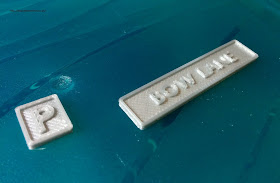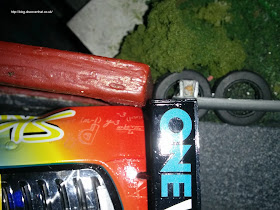The windows on the rear passenger doors of the discovery are split in two. A rectangular section can be opened and the rest is a small fixed angled pane.
The frame that divides the two glass panels is thin. I've used a short length of black 1mm nail tape for this frame.
The glue on the tape is not that strong so a layer of gloss varnish, over the whole window, holds it more securely.
I've also used a tiny length of gold nail tape for the indicator repeater.
While I had all the bits in one place, I mocked up the finished car. I then glued in the interior using canopy glue.
A final job for this weekend was to solder in the digital SSD chip, so the chassis is ready to fit.
▼
Saturday, 27 February 2016
A little fence
My track has always had a small area that I call the car park. It fits two cars and I cut slots for the blade of the guide to drop in to so the wheels touch the ground.
I decided it needed a sign to formalise it as a car park. I also needed something to fix the sign to that was a bit more robust than a post. Previous cat photos make it obvious why a thin post might not survive very long. A short length of picket fence fitted the bill.
A nice simple shape to design and 3D print.
The parking 'P' sign was slightly more complicate.
At the same time as making the car park sign, I've made some street name plates for a few of the roads on the track. I'll come back to those in another post.
The end posts of the picket fence are 4mm square and fit snugly in to 6mm holes in the scenery to hold the panel up.
Downloads:
Picket Fence STL file
Picket Fence Blend file
Picket Fence licence attribution
==
I decided it needed a sign to formalise it as a car park. I also needed something to fix the sign to that was a bit more robust than a post. Previous cat photos make it obvious why a thin post might not survive very long. A short length of picket fence fitted the bill.
A nice simple shape to design and 3D print.
The parking 'P' sign was slightly more complicate.
At the same time as making the car park sign, I've made some street name plates for a few of the roads on the track. I'll come back to those in another post.
Downloads:
Picket Fence STL file
Picket Fence Blend file
Picket Fence licence attribution
==
Monday, 22 February 2016
Number plate decals
It has been many decades since I last had anything to do with water slide transfers. They bring back memories of Airfix kits.
The world has changed and now I can print out my own decals on to laser printer water slide paper. I was very impressed by how easy it was to use, both printing and applying to the model.
The transfers are stronger than I remember and slide off more easily. I used a cotton bud to wet the surface and tweezers to lift the cut decals in to and out of the water bath. I found that my fingers were the only way to get the transfer from the paper to the model.
I was able to make minor adjustments to the position with the wet cotton bud and the dry end to dab away the excess water.
I used white transfer paper. I would have preferred transparent but normal laser printers cannot print white and the colour balance is adjusted for printing on a white background.
Despite using a sharp knife the white edge is visible. That's a bit disappointing but was only significant when I was printing a largely black shape. Partly because of that and partly because I did not think I could cut a straight enough edge, I decided not to apply the window frame transfers I have designed.
The number plates worked very well which were the most important.
The world has changed and now I can print out my own decals on to laser printer water slide paper. I was very impressed by how easy it was to use, both printing and applying to the model.
The transfers are stronger than I remember and slide off more easily. I used a cotton bud to wet the surface and tweezers to lift the cut decals in to and out of the water bath. I found that my fingers were the only way to get the transfer from the paper to the model.
I was able to make minor adjustments to the position with the wet cotton bud and the dry end to dab away the excess water.
I used white transfer paper. I would have preferred transparent but normal laser printers cannot print white and the colour balance is adjusted for printing on a white background.
Despite using a sharp knife the white edge is visible. That's a bit disappointing but was only significant when I was printing a largely black shape. Partly because of that and partly because I did not think I could cut a straight enough edge, I decided not to apply the window frame transfers I have designed.
The number plates worked very well which were the most important.
Despite it working well, because of the white edge, I'm not sure there is any advantage over using normal paper.
Track bumper
The Audi R8 that I received from Don for my birthday last July is an excellent car to drive.
It holds the track well and can accommodate a bit of drifting at corners without de-slotting.
It does have a slight issue. The trouble is that its rear fin is a millimeter wider than the rear body. There is one place on the track where it drifts out and the fin regularly gets knocked off. I probably superglue it back on two out of three times I drive it!
To reduce that I have added a couple of extra tyres to the edge of the track. This is just enough to stop the fin hitting.
Unfortunately while testing I got carried away and although I was no longer able to make it make contact at that corner, it did not stop me getting carried away at another corner, which de-slotted and collided fin first in to the cliff wall. I still had to glue to fin back on!
At least now it takes driver error or obstacles on the track to cause damage!
It holds the track well and can accommodate a bit of drifting at corners without de-slotting.
It does have a slight issue. The trouble is that its rear fin is a millimeter wider than the rear body. There is one place on the track where it drifts out and the fin regularly gets knocked off. I probably superglue it back on two out of three times I drive it!
To reduce that I have added a couple of extra tyres to the edge of the track. This is just enough to stop the fin hitting.
Unfortunately while testing I got carried away and although I was no longer able to make it make contact at that corner, it did not stop me getting carried away at another corner, which de-slotted and collided fin first in to the cliff wall. I still had to glue to fin back on!
At least now it takes driver error or obstacles on the track to cause damage!
Wednesday, 17 February 2016
Ship Cargo Winch Model
A friend, Don, had been looking for a small cargo winch for a model ship he was making.
He'd seen some very good models produced using 3D printing. My guess is these were professional prints and I was unsure if my 3D printer could create sufficient quality models in the tiny size required for these winches. I eventually thought I could give it a go.
The 1:150 plans are a bit vague on the details of the winch but I was able to find a web site about a similar ship. http://www.lanevictory.org/laneVtour_mast_boom.php
The above are some useful photos of the winches from that site. Those combined with some photo's of the model, as work in progress, I was able to guess a suitable scale.
I've created a 3D model based on those photos.
The winches are very small at the scale of the model. About 12mm wide by 11mm tall. The first attempt needed some adjustment to try to get a better result.
The main change was to remove the tiny locating pins. They just ended up as melted blobs, each being smaller than 1mm.
The pin holes however worked well so if an alignment pin is required to locate the 3 parts a tiny brass rod could be used. I have found it very easy to align the parts without using anything to align them. Just super glued together.
The lesson learnt from this is that a tiny tube prints out much better than a tiny solid cylinder.
I am happy with the end result. Hopefully they will look good in place on the ship.
3D Printer settings:
Layer height 0.1mm
Fill density 100% (solid)
Print speed 30 mm/s
Downloads:
Blend file
STL files (zip)
Licence attribution
==
He'd seen some very good models produced using 3D printing. My guess is these were professional prints and I was unsure if my 3D printer could create sufficient quality models in the tiny size required for these winches. I eventually thought I could give it a go.
The 1:150 plans are a bit vague on the details of the winch but I was able to find a web site about a similar ship. http://www.lanevictory.org/laneVtour_mast_boom.php
The above are some useful photos of the winches from that site. Those combined with some photo's of the model, as work in progress, I was able to guess a suitable scale.
I've created a 3D model based on those photos.
The winches are very small at the scale of the model. About 12mm wide by 11mm tall. The first attempt needed some adjustment to try to get a better result.
 |
| First attempt with a melted mess where a pin should be |
 |
| Revised design |
The main change was to remove the tiny locating pins. They just ended up as melted blobs, each being smaller than 1mm.
The pin holes however worked well so if an alignment pin is required to locate the 3 parts a tiny brass rod could be used. I have found it very easy to align the parts without using anything to align them. Just super glued together.
The lesson learnt from this is that a tiny tube prints out much better than a tiny solid cylinder.
I am happy with the end result. Hopefully they will look good in place on the ship.
3D Printer settings:
Layer height 0.1mm
Fill density 100% (solid)
Print speed 30 mm/s
Downloads:
Blend file
STL files (zip)
Licence attribution
==
Wednesday, 10 February 2016
ISPConfig 3 Web Forwarding
My mail and web host provider is in the process of upgrading their control panel software along with putting in a new server.
I struggled to find documentation for what I wanted to do with the new software. There is a very limited amount of documentation on the following site:
http://docs.ispconfig.org/
It did not cover my requirement for very simple web forwarding.
The DNS server for my domain is hosted on this new server but my blog is hosted elsewhere.
The following screenshots show examples of the settings I needed to enter to get web forwarding to work to a Google Blogspot site. They may not be the only way, nor the best but they worked today:
Beware of web browsers caching and of DNS refresh times, particularly the Time To Live (TTL.)
Watch out for the final dot in the host names in the DNS records data column. Without the dot the host is treated as a sub-domain and appended to the root domain of the zone. You'd get 'isp1.refinitive.com.anewleaf.org.uk' instead of 'isp1.refinitive.com'
While testing, I set the TTL for the domain and the individual hosts to be 5 minutes (300 seconds) but despite that Chrome cached the incorrect web site. I needed to clear the browsing history before I could see the changes working.
This was all trial and error, hence these instructions.
I believe, but I'm not confident that the abbreviation R, in the above, means redirect and the L means don't process any further rules on that host name. Anyway the example I based this on suggested always using the R,L type.
The following bit is only necessary if you want to redirect the root domain to a web site.
For example: http://anewleaf.org.uk to got to http://www.anewleaf.org.uk
Like the alias forwarding you also need a CNAME record in the DNS for the host, in this case 'www'.
After a couple of days of use, with everything working as it should, I reverted the TTL's back to 3,600 seconds for the host names and 50,000 seconds for the domain.
I struggled to find documentation for what I wanted to do with the new software. There is a very limited amount of documentation on the following site:
http://docs.ispconfig.org/
It did not cover my requirement for very simple web forwarding.
The DNS server for my domain is hosted on this new server but my blog is hosted elsewhere.
The following screenshots show examples of the settings I needed to enter to get web forwarding to work to a Google Blogspot site. They may not be the only way, nor the best but they worked today:
 |
| Create the DNS zone first |
Beware of web browsers caching and of DNS refresh times, particularly the Time To Live (TTL.)
 |
| Add a CNAME for the sub-domain you want to forward |
While testing, I set the TTL for the domain and the individual hosts to be 5 minutes (300 seconds) but despite that Chrome cached the incorrect web site. I needed to clear the browsing history before I could see the changes working.
 |
| Add a top level web site |
 |
| Add an alias to redirect to any other URL |
I believe, but I'm not confident that the abbreviation R, in the above, means redirect and the L means don't process any further rules on that host name. Anyway the example I based this on suggested always using the R,L type.
The following bit is only necessary if you want to redirect the root domain to a web site.
For example: http://anewleaf.org.uk to got to http://www.anewleaf.org.uk
 |
| Settings on the site Redirect tab |
After a couple of days of use, with everything working as it should, I reverted the TTL's back to 3,600 seconds for the host names and 50,000 seconds for the domain.
Sunday, 7 February 2016
Track and Cars
I've found the time to work on both my track and my model Land Rover Discovery 2.
I've been gluing in the windows of the Discovery. Yet again, I was not happy with the first attempt at gluing in the windows. I removed that attempt, trimmed it up and refitted more flush with the body.
I've also added a black border round each glass panel.
I used a long wooden stirring stick to put small drops of canopy glue along the edges of the clear plastic window inserts.
On the track I added another tyre wall where cars tend to drift out and hit a barrier very hard.
I've been gluing in the windows of the Discovery. Yet again, I was not happy with the first attempt at gluing in the windows. I removed that attempt, trimmed it up and refitted more flush with the body.
I've also added a black border round each glass panel.
I used a long wooden stirring stick to put small drops of canopy glue along the edges of the clear plastic window inserts.
On the track I added another tyre wall where cars tend to drift out and hit a barrier very hard.




















































